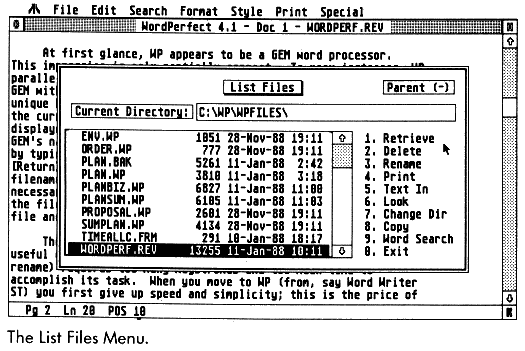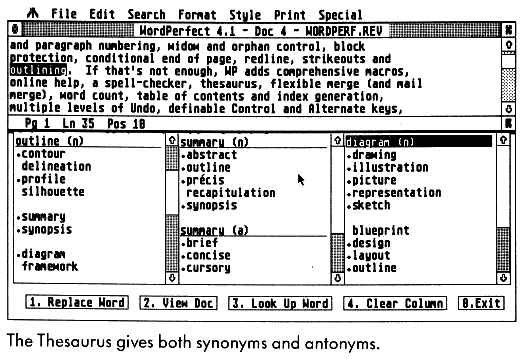WORD
PERFECT
IS IT PERFECT YET?
By Ian Chadwick
Using WordPerfect 4.1 (WP) for the ST is like driving a Ferrari through rush-hour traffic. The potential for phenomenal performance is there, but unfortunately, WP seems to spend most of its time stalled at the side of the road, rather than leading the pack.
WP brings to the ST features and functionality light years beyond its competitors. The program has so many features that you may not get to many of them until long after you've brought it home. Along with this wealth, however, comes a proportionate level of effort required to master WP. The learning curve isn't steep, but it is long.
WORDPERFECT FFATURES
WordPerfect's list of features is impressive. In up to four simultaneous
document windows, it offers complete line and page format control, including
page centering, binding width print allowance, newspaper and parallel columns,
headers, footers, footnotes, endnotes, automatic hyphenation, Roman or
Arabic page and paragraph numbering, widow and orphan control, block protection,
conditional end of page, redline, strikeouts and outlining. If that's not
enough, WP adds comprehensive macros, online help, a spell-checker, thesaurus,
flexible merge (and mail merge), word count, table of contents and index
generation, multiple levels of Undo, definable Control and Alternate keys,
math functions, file search and display, automatic timed backups and search
and replace on any character, including carriage returns. Virtually everything
is user definable, from the cursor to the underline style. The power in
this program is staggering, even intimidating.
With all this power, the question is: are you ready for WordPerfect? More important, given the current state of its development, is WordPerfect ready for you? Perhaps the rest of this article will help you decide.
KEYBOARD INTENSIVE
WP is keyboard intensive, reflecting its non-GEM roots. Each function
key pressed alone or with the Shift, Control or Alt keys performs a different
task. You can select every WP feature from the keyboard, although the commands
are often confusing and rarely mnemonic. Some commands are mouse-selectable
in the pull-down menus while others pop up in dialog boxes. Many selections
offer still more choices and subsequent dialog boxes. It may take half-a-dozen
keystrokes or mouse clicks to accomplish a single task.

WordPerfect Corporation has done its best to rescue the user drowning in choices. The on-line help is excellent and the program comes with a keyboard template, key stickers, a quick reference card and a 600-page manual. If you're a new WP user, be sure to keep all the documentation handy. You'll need it.
At first glance, WP appears to be a GEM-based word processor. This impression is only partially correct. In many instances, WP parallels the IBM PC version and many of its routines circumvent GEM with mixed success. For example, pressing the F5 key brings up a unique List Files menu with a variety of disk functions. Then the current directory is read, sorted alphabetically and displayed complete with names, sizes and dates-far superior to GEM's name-only output. You can then choose a file and function by typing in the filename or by using the mouse or the cursor and Return keys. You can't simply do a GEM double-click on a filename to load it. It's an annoyance at times, but it was necessary to allow multiple file selection. If you already know the filename and path, you can simply press the Shift and the F10 key to load a file and avoid this menu completely.

The List Files Menu is typical of WP: a good utility with useful options (including text in, disk file search, delete and rename) that requires too many keystrokes and too much time to accomplish its task. When you move to WP (from, say, Word Writer ST) you first give up speed and simplicity; this is the price of WP's power.
WHAT YOU SEE...
WP is partially WYSIWYG: boldface, underlining and italics are displayed
and text appears on the screen where it will on paper. But headers, footers
and foot- and endnotes are hidden until print time, when they appear where
you hope they should. You can edit them in their own windows, but not preview
them in the document- to me, a serious failing.
Footnote and endnote references are identified in the text by a number the same size and color of the body of the text. There's no way to distinguish these numbers from other text (italics, bold and underline don't affect them). At print time, the numbers are superscripted (if that's what you chose), but not in the screen display. Also, long footnotes cause unpredictable and unwanted page breaks or can even cause the computer to crash.
Because of WP's flexibility, embedded control codes can multiply like rabbits. They are, therefore, invisible in the document window. If you select Reveal Codes by pressing the Alt and F3 keys, the text, formatting and printer commands appear in a separate window below the main document window. You can delete the commands there, but you can only insert them in the main window. Since the mouse is turned off when you reveal codes, you move with the cursor keys. The code window scrolls annoyingly with every movement and often codes scroll up out of sight; you cannot resize the code window.
PORTING FILES AND SETTING MACROS
You can port text files-not macros-directly from IBM WP to your ST,
but they must be in the WP 4.1 format. ST WP has serious trouble digesting
files created in the 4.2 version.
Macros are a major WP feature you can use to customize your own copy. Essentially, a macro is a collection of keystrokes- either commands or text. After you name a macro, you type and press keys in the order you wish everything performed and save it to disk. When you invoke that macro, keystrokes are repeated exactly as entered - provided they are stored in the current directory.
Unfortunately, WP macros on the ST don't always work properly. For example, I created a macro to open a window, sized it to the top half of the screen, loaded a file from disk, opened a second window, sized it to the bottom half, loaded a second file and inserted some text. In IBM version 4.2 this is simple stuff. In ST 4.1, window number one opened, sized itself correctly and loaded the file. Number two opened, but remained at full size. It refused to load the next file and forgot the text.

Sometimes a redefined macro won't respond-although saved, only the original
definition works. Other times, working macros seem to get forgotten and
stop working after performing flawlessly earlier in a document.
|
The ST and Amiga versions are based on the IBM Version 4.1. IBM Version 4.2, released in late 1986, has enhancements aimed at the legal market, including a table of authorities, an index concordance (for phrases), document summary; line numbering and sorting. These are not. however, the sum of differences between 4.1 and 4.2:
|
THE SPELL CHECKER AND THESAURUS
With WP's large 115,000-word spell checker you can skip words, add
them to its dictionary and perform phonetic lookup. When it finds a misspelling,
it attempts to make an intelligent guess at what you mean, but sometimes
it generates bizarre suggestions, eg., "thur" as a replacement for "thru."
I found the spell checker consistently hung on common words ("dictionary,"
"characters," etc.) in large files. Word count on the latest revision (January
29th) is erratic, on some WP copies it works, while on others it doesn't.
Finally, you can't add words with numbers in them (eg., "2nd") to the dictionary.
The thesaurus is another mixed blessing. It offers both synonyms and antonyms and the ability to replace a word in text with one of the alternate words it lists. However, you cannot add to the definitions or search on capitalized or uppercase words (it can find "easy" but not "Easy" or "EASY").
WordPerfect 4.1
is like driving a Ferrari
through rush-hour
traffic.
FILE FORMATS AND PRINTER DRIVERS
WP files are in a non-ASCII format, but you can save files in ASCII
or print them to disk. CONVERT.PRG, provided with WP, can translate a file
from 1ST Word or Word Writer to WP format, but not the other way around.
The January 8th revision also offered conversion from ST Writer, but it
was buggy and was deleted from the January 29th revision.
Although many are only partially supported, 259 predefined printer drivers are provided. Six printer definitions can be chosen at one time for the system. You can also create or edit printer drivers using the included utility program and your printer manual.
BUT WAIT, THERE'S MORE
Installation of WP is not very clear; nowhere are you told what files
should be installed with what programs or given suggestions for optimum
use of disks. You may have to make several attempts before you get a working
system configured to your liking.
WPSTART.PRG lets you define the system paths, directory location and a range of default variables including the directory; justification, hyphenation, tabs, line and page sizes. When I defined system and virtual paths as C:, WP blithely ignored my setup and used C:\WP instead, but produced error messages to compensate. With everything set to C:\WP, I had no problems. (Editor's note: WPSTART.PRG also has the annoying habit of locking up for no apparent reason, and the January 29th version is no better.)

I highly recommend a hard disk for using WP. With two double-sided drives, the program, macros and configured printer files should be on the disk in drive A. The spell dictionaries and thesaurus should be on one disk and inserted into drive B when needed. Trying to use WP on a single-disk drive system is almost impossible.
WP uses the disk as virtual memory: files too large to fit into memory are stored in portions on the disk (areas above and below the cursor, in separate files). This permits you to create and edit very large files, but you must have disk space available to handle them. Swapping large files between disks and memory is time consuming, even with a hard disk. Moreover, WP creates a variety of disk files for various purposes, from blocks to deleted text. These can eat up free disk space at an alarming rate.
FROM FIRST WORD TO LAST WORD?
For almost every WordPerfect feature there is some drawback, mostly
because the program is, well, unfinished. On one hand, WordPerfect offers
a wealth of power and features; on the other hand, WordPerfect is a monstrous
program, making inadequate compromises with the operating system and still
plagued with bugs.
I'm tempted to dismiss this version as half-hearted and not worth the trouble, but WordPerfect Corporation has a good reputation. They have great customer support and put an enormous amount of time and effort into their products. I'm convinced that they will continue to improve this program until it lives up to its name-perfect. Ask your local dealer or other users to tell you if the latest version is stable. Also, keep in mind that WordPerfect's $395 suggested retail price tag is quite misleading; a number of computer dealers are offering it in the low $200s and members of the educational community (both teachers and students) can purchase it for only $99. (Contact your local WordPerfect dealer for details.)
But above all, bear with its teething pains. It should get better.
If you'd like to see more articles like this one, circle 157 on the Reader Service Card.
Ian Chadwick is a free-lance writer and the author of the classic Atari 8-bit reference book Mapping the Atari.
PRODUCTS MENTIONED
-
WordPerfect For The Atari ST, $395. WordPerfect Corporation, 288
West Center Street, Orem, UT 84057, (801) 225-5000.
CIRCLE 158 ON READER SERVICE CARD